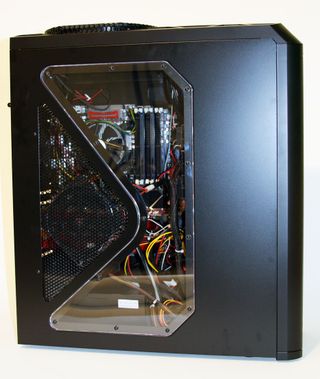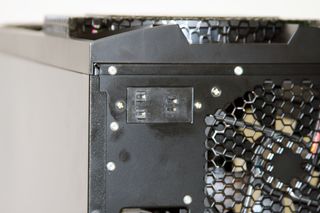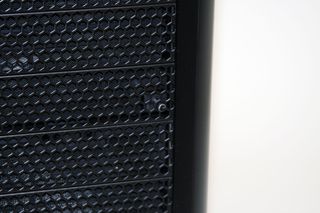Four Full Tower Cases From $150 To $600
Antec Twelve Hundred--Unpacking And Build
$155

Unpacking
After the majestic-looking brushed aluminum Canyon, any other chassis would have a hard time sizing up—that is, until you start taking price into consideration. Antec’s Twelve Hundred can almost be considered something of a reference standard by which to measure other towers, thanks to the company’s history of designing functional, inexpensive cases. And with a price tag under $160, you could buy more than three Twelve Hundreds for the price of a single Canyon 695. Suddenly, we’re a lot more interested.
Puling Antec’s packaging open reveals a plastic-wrapped tower sandwiched between foam—and not the kind that crumbles apart when you try to pull the case out, either. Two thumb screws hold each side-panel in place. Pull off the instruction manual taped to the side, open the left panel, and remove the small accessory box. Antec bundles cable ties, plenty of screws, washers, and an adapter for turning one of its 5.25” externally-facing bays into a 3.5” slot.
Build

Like the Cooler Master case we’ll be looking at next, Antec opts for a more open design, enabling plenty of airflow at the expense of acoustic insulation. The entire front, most of the top, a triangular section of one side panel, and much of the Twelve Hundred’s rear is covered by a metal grille. A slow-spinning 200 mm fan sits under the top of the case, three 120 mm intake fans pull air in through the front, and a pair of 120 mm exhaust fans in the back push warm air out. All of the fans include blue LEDs for an extra bit of visual flair, but for the folks who’d rather not boast the bling, they can be turned off.

Although certain pieces of the case are clearly plastic, the rest is built using steel—and the shipping weight of 42 pounds reflects this. Not that you’d want to lug any of our four featured chassis around to LAN parties, but the Twelve Hundred in particular is a herniated disc waiting to happen.
Stay on the Cutting Edge
Join the experts who read Tom's Hardware for the inside track on enthusiast PC tech news — and have for over 25 years. We'll send breaking news and in-depth reviews of CPUs, GPUs, AI, maker hardware and more straight to your inbox.
Front-panel connectivity is on show, front and center. Like most of the other towers we’re seeing, power and reset switches are up at the top in easy reach. Between them, you’ll find USB, eSATA, and audio I/O. The left side panel is windowed, providing a glimpse into the wonderful world of your hardware. A fan bracket mounted to that same panel accepts an extra 120 mm cooler, if you see fit to add it. Around back is where you’ll find fan speed/LCD controls, cutouts for water cooling components, and seven expansion slots (that’s right—no room for three GTX 280s, if that was what you were planning.
Current page: Antec Twelve Hundred--Unpacking And Build
Prev Page ABS Canyon 695--Build And Installation Next Page Antec Twelve Hundred--Build And Installation-
Proximon Thank you Chris, another very useful article. Not enough case comparisons around, as I'm sure you realized.Reply
I'll be sure to add the HAF to my recommendation list. I hadn't before because I thought all the extra holes would hinder cooling more than help. The hole in the MB tray sounds especially useful.
I would have liked to see on of the Cosmos cases included, although I suspect they are simply quieter but hotter. -
malveaux Nice article.Reply
Though, I'm curious. 40db+ isn't whisper quiet. That's freak'n loud. What's up with calling it whisper quiet? -
Pei-chen The three cheaper cases are powerhouses but too big and overkill for most people including gamers. I think the Antec's Three Hundred ($60 a few weeks ago on Newegg) suits the need for most people. 750w PSU are usually enough for SLI/Crossfire so 1000w+ aren't needed.Reply -
malveaux I'm curious when they will start releaseing more cases that have more depth, so that they have more room for today's much larger videocard solutions.Reply -
kubes Ya I agree that case designers should consider making them have more depth. With this in mind though i'm sure vidoe card manufactors will only make their card even longer however.Reply -
antiacid Good article. Now it gives a procedure and template to test other cases as well. It'd be great to have a review of cases which could be "best of" a certain category (cooling, noise, ease of use, weight, etc). It would be even nicer if the results were put in bullet point form and were setup in a table like the ones used in hdd/video card tables. That would make it a lot easier to compare everything.Reply -
avatar_raq I do believe that all the cases available in the market these days are poorly designed especially when it comes to air flow. You may notice that front fans, rear fans, buttom, side and top panel fans -when combined- cause turbulence in air flow that reduces the overall air flow. That's why I buy a cheap $25 case and modded myself!!!Reply
I have so many innovations regarding case designs that I hope someone buys them and excutes them in reality!! -
avatar_raq Here is one of my ideas...Reply
To put it plainly: air needs to be moved in one direction, preferably from down-upwards, since hot air tends to go upward by nature and the hottest part of any system (that's the GFX cards) is located at the lower part..Hence a PSU mounted at the upper part of the case (with its 120-140mm fan), with another 120mm top-panel exhaust fan and two 120mm buttom intake fans will be by far more efficient than all the available cases. To achieve this efficincy I close any other holes (even the ones the manufacturer meant for ventilation) so the air enters the case only from the buttom fans where I put dust filters to minimize dust inside my case. Furthermore I use a case with long "legs" to minimize inhalation of the dust at my desk's surface.
To minimize noise: I use
1.low RPM silent fans.
2.rubber washers between the fans and the case to minimize vibration noise.
3.cover all the interior surfaces with a layer of an insulator, that can be as simple as sponge!!!
4.even design external air ducts that divert the exhausted air (which carries the interior noise) to the back. -
avatar_raq Fortunately many aftermarket CPU and GPU coolers helped me. They can be installed in a way that the fan moves the air upwards. There is evidence that the setup I suggested above reduces -though marginally- the power consumed by the CPU and GPU fans to reach thier designated rpm and increases the lifetime of these fans, since instead of meeting resistance, the one directional air flow helps them.Reply
Most Popular


